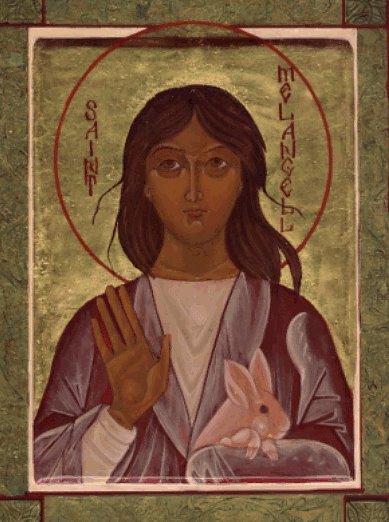
Although ornately decorated inside, boasting of its own
miraculous icon (or
icons?), and blessed with a wonderful choir, the Bloomington's
All Saints' Orthodox Church presently looks from outside more like a small office building than a traditional Orthodox Christian "Temple of God". In Russian, it can be described it as
ni kupolov, ni kolokolov: "No dome, and no bells!".
The congregation's hope is that some day the existing church building (constructed in the early 2000s) will will indeed become its office/classroom space, while the divine worship will move to a beautiful new neo-Byzantine building (yes, complete with a dome!). But that's a long way off.
 On the other hand, the church is getting its bells! They have already arrived and are to be mounted on what the church proudly calls its "bell tower" (actually, just a simple wooden stand). They will be officially "blessed" on Sunday, November 14, right after the Divine Liturgy (which starts at 10:00, and typically runs for around 1.5 hours). See allsaintsbloomington.org for the schedule of services.
On the other hand, the church is getting its bells! They have already arrived and are to be mounted on what the church proudly calls its "bell tower" (actually, just a simple wooden stand). They will be officially "blessed" on Sunday, November 14, right after the Divine Liturgy (which starts at 10:00, and typically runs for around 1.5 hours). See allsaintsbloomington.org for the schedule of services.
All Saints' is quite a remarkable church, with its roots more American than "ethnic". Although part of the Patriarchate of Antioch, it owes its existence, it seems, more to the turning of some American Protestants to the Orthodox way of worship rather than to any large-scale migration of Middle Eastern Christians to South Central Indiana.
A self-described "Pan-Orthodox" congregation, All Saints' can be fairly described as a truly "American Orthodox" church:
- the service is all in English (except for a few obligatory Kirie eleison and Gospodi pomilui
- the "New" (Gregorian) Calendar is used, same as what Catholics and most Protestants use these days
- the Royal doors in the center of the iconostasis are, in fact a permanent opening, without actual doors! Which means that you can actually see the priest(s) and deacons(s) throughout the service, and not just hear them. (And to hear them better, there is a PA system as well...)
- quite a few saints featured in their icons have lived in the United States (or what's today the United States), and at least a couple actually were US citizens
- there are seats for everyone in the audience (not that you get to sit much, of course, this being an Orthodox Temple, after all!)
- they have mixed seating (or, well, standing), and the women in the audience are mostly bareheaded
 It's nice to know that rabbits and hares have a heavenly patron too: Virgin Saint Melangell, Abbess in Wales. As she lived long before the Great Schism, she is venerated not only by Catholics and Anglicans, but also by the Orthodox! Icons of her have been painted as well.
It's nice to know that rabbits and hares have a heavenly patron too: Virgin Saint Melangell, Abbess in Wales. As she lived long before the Great Schism, she is venerated not only by Catholics and Anglicans, but also by the Orthodox! Icons of her have been painted as well.







